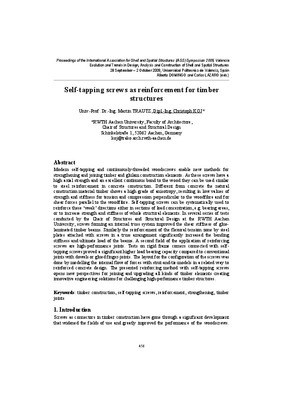JavaScript is disabled for your browser. Some features of this site may not work without it.
Buscar en RiuNet
Listar
Mi cuenta
Estadísticas
Ayuda RiuNet
Admin. UPV
Self-tapping screws as reinforcement for timber structures
Mostrar el registro sencillo del ítem
Ficheros en el ítem
| dc.contributor.author | TRAUTZ, Martin
|
|
| dc.contributor.author | KOJ, Christoph
|
|
| dc.contributor.editor | Domingo Cabo, Alberto
|
es_ES |
| dc.contributor.editor | Lázaro Fernández, Carlos Manuel
|
es_ES |
| dc.date.accessioned | 2009-12-01T08:25:23Z | |
| dc.date.available | 2009-12-01T08:25:23Z | |
| dc.date.issued | 2009-12-01T08:25:23Z | |
| dc.identifier.isbn | 978-84-8363-461-5 | |
| dc.identifier.uri | http://hdl.handle.net/10251/6537 | |
| dc.description | p. 456-467 | en_EN |
| dc.description.abstract | Modern self-tapping and continuously-threaded woodscrews enable new methods for strengthening and joining timber and glulam construction elements. As these screws have a high axial strength and an excellent continuous bond to the wood they can be used similar to steel reinforcement in concrete construction. Different from concrete the natural construction material timber shows a high grade of anisotropy, resulting in low values of strength and stiffness for tension and compression perpendicular to the woodfibre and for shear forces parallel to the woodfibre. Self-tapping screws can be systematically used to reinforce these `weak¿ directions either in sections of load concentration, e.g. bearing areas, or to increase strength and stiffness of whole structural elements. In several series of tests conducted by the Chair of Structures and Structural Design at the RWTH Aachen University, screws forming an internal truss system improved the shear stiffness of gluelaminated timber beams. Similarly the reinforcement of the flexural tension zone by steel plates attached with screws in a truss arrangement significantly increased the bending stiffness and ultimate load of the beams. A second field of the application of reinforcing screws are high-performance joints. Tests on rigid frame corners connected with selftapping screws proved a significant higher load bearing capacity compared to conventional joints with dowels or glued finger-joints. The layout for the configuration of the screws was done by modelling the internal flow of forces with strut-and-tie-models in a related way to reinforced concrete design. The presented reinforcing method with self-tapping screws opens new perspectives for joining and upgrading all kinds of timber elements creating innovative engineering solutions for challenging high-performance timber structures. | en_EN |
| dc.language | Inglés | en_EN |
| dc.publisher | Editorial Universitat Politècnica de València | es_ES |
| dc.relation.ispartof | Symposium of the International Association for Shell and Spatial Structures (50th. 2009. Valencia). Evolution and Trends in Design, Analysis and Construction of Shell and Spatial Structures : Proceedings | en_EN |
| dc.rights | Reserva de todos los derechos | en_EN |
| dc.subject | Timber construction | en_EN |
| dc.subject | Self-tapping screws | en_EN |
| dc.subject | Reinforcement | en_EN |
| dc.subject | Strengthening | en_EN |
| dc.subject | Timber joints | en_EN |
| dc.title | Self-tapping screws as reinforcement for timber structures | en_EN |
| dc.type | Comunicación en congreso | en_EN |
| dc.rights.accessRights | Abierto | es_ES |
| dc.description.bibliographicCitation | Trautz, M.; Koj, C. (2009). Self-tapping screws as reinforcement for timber structures. Editorial Universitat Politècnica de València. http://hdl.handle.net/10251/6537 | es_ES |
| dc.relation.conferencename | Symposium of the International Association for Shell and Spatial Structures | es_ES |
| dc.relation.conferencedate | 2009 | es_ES |
| dc.relation.conferenceplace | Valencia | es_ES |






